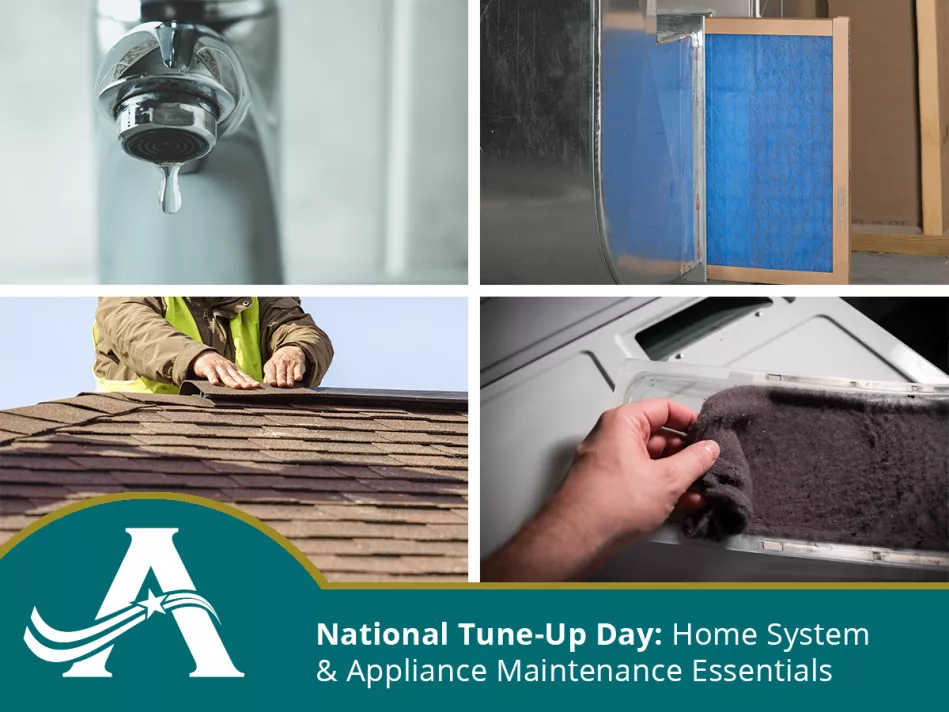You don’t need to be mechanic or home repair expert to maximize the life of home systems and appliances. All it takes is some simple, scheduled maintenance to keep everything running smoothly for longer.
In honor of National Tune-Up Day, explore these helpful tips from APHW on maintaining essential home systems and appliances.
Unclog Plumbing Drains
Soap, hair, and food waste are notorious for clogging drains. If grease is getting in your drain’s way, give it a heavy dose of hot water and dishwashing liquid to emulsify the fat and clear the clog. For hair clogs, use a plunger or small drain snake to bring the clog to the surface so it can free the waterflow.
Please note: Drano and other harsh chemicals can hurt your plumbing, so if you can’t remove the clog, call a professional.
Fix a Leaky Faucet
Worn-out rubber washers are the main reason why most faucets leak. To fix your faulty faucet, simply turn off your sink’s water supply at the source, unscrew the handle where the leak is located, and swap out the old washer for a new one. Once you’ve reassembled your faucet, turn the water back on slowly to make sure it’s running smoothly.
Drain the Water Heater
Water contains sediment that can build up in your water heater and cause lots of damage. That’s why experts recommend draining and cleaning it at least once a year by:
- Shutting off the power to your water heater (or turning the thermostat down all the way on gas-powered heaters)
- Connecting a hose to its outlet
- Letting it drain somewhere safe
- Restarting the water supply for a few minutes to clean the tank
- Closing the valve and turning on the power
Change the A/C Filters
Air filters can clog relatively fast, making it difficult for your A/C system to circulate cold air. Every 30 days (or more often during peak usage), make sure to change your A/C filters to keep clean air flowing to and from your unit.
Check for Washing Machine Leaks
Leaky supply lines on washing machines are one of the main reasons for water damage claims. This is why it’s important to check washing machine supply lines at least once a year, and replace any hoses that show rust and discoloration, damage, or leakage.
The same applies to your washing machine drain hose – if you see water draining where it doesn’t belong, inspect the hoses and fixtures to ensure they fit snugly, are in good condition, and are draining properly. If anything doesn’t look or work right, it’s best to just replace it.
Prevent a Dryer Fire
Last year over 13,000 fires started in clothes dryers – and more than 25 percent could have been prevented with simple dryer maintenance. To keep your dryer in tip-top shape, clean the lint trap after every dryer cycle, and remove any lint buildup from your dryer’s exhaust every six months. Not only will this help you prevent a dryer fire, it can also help your dryer’s heating element last longer.
Clean the Fridge’s Coils
Dirty coils can hurt your refrigerator, so make sure to run your vacuum’s brush attachment over these coils periodically to remove dirt and dust. Since these coils are used by your refrigerator to keep everything cool, any buildup can lower its efficiency or cause it to stop working altogether without some maintenance.
Perform a Roof Inspection
A leaky roof can cause all kinds of problems for homeowners, including mold, water damage, and even fire hazards. To prevent problems like these, inspect your roof periodically for any damaged or discolored shingles – especially around vents, chimneys, and skylights –and replace them immediately.
Your home systems and appliances won’t last forever, even with regular maintenance. Discover how to protect them from normal wear and tear with an APHW home warranty.
Visit us on Facebook, LinkedIn, Twitter or Instagram to tell us your thoughts!

